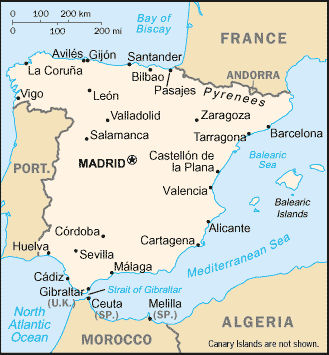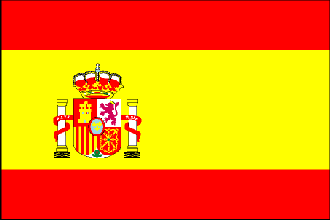
|
Spain
Background:
Spain's powerful world empire of the 16th and 17th centuries ultimately yielded
command of the seas to England. Subsequent failure to embrace the mercantile
and industrial revolutions caused the country to fall behind Britain, France,
and Germany in economic and political power. Spain remained neutral in World
Wars I and II, but suffered through a devastating civil war (1936-39). In the
second half of the 20th century, Spain has played a catch-up role in the
western international community. Continuing concerns are Basque Fatherland and
Liberty (ETA) terrorism and further reductions in unemployment.
Location:
Southwestern Europe, bordering the Bay of Biscay, Mediterranean Sea, North
Atlantic Ocean, and Pyrenees Mountains, southwest of France.
Area: Total: 504,782 sq km, water: 5,240 sq km, note: there are 19 autonomous
communities including Balearic Islands and Canary Islands, and three small
Spanish possessions off the coast of Morocco - Islas Chafarinas, Penon de
Alhucemas, and Penon de Velez de la Gomera, land: 499,542 sq km.
Area - comparative: Slightly more than twice the size of Oregon.
Land boundaries: Total: 1,917.8 km, border countries: Andorra 63.7 km, France
623 km, Gibraltar 1.2 km, Portugal 1,214 km, Morocco (Ceuta) 6.3 km, Morocco
(Melilla) 9.6 km.
Coastline: 4,964 km.
Climate and Terrain:
Climate: Temperate; clear, hot summers in interior, more moderate and cloudy
along coast; cloudy, cold winters in interior, partly cloudy and cool along
coast.
Terrain: Large, flat to dissected plateau surrounded by rugged hills; Pyrenees
in north.
Natural resources: Coal, lignite, iron ore, uranium, mercury, pyrites,
fluorspar, gypsum, zinc, lead, tungsten, copper, kaolin, potash, hydropower,
arable land.
People:
Population: 40,077,100.
Ethnic groups: Composite of Mediterranean and Nordic types.
Religions: Roman Catholic 94%, other 6%.
Languages: Castilian Spanish (official) 74%, Catalan 17%, Galician 7%, Basque
2%.
Government:
Government type: Parliamentary monarchy.
Capital: Madrid.
Economy overview:
Spain's mixed capitalist economy supports a GDP that on a per capita basis is
80% that of the four leading West European economies. Its center-right
government successfully worked to gain admission to the first group of
countries launching the European single currency on 1 January 1999. The AZNAR
administration has continued to advocate liberalization, privatization, and
deregulation of the economy and has introduced some tax reforms to that end.
GDP - composition by sector: Agriculture: 4%, industry: 28%, services: 68%.
Statistics:
Telephones - main lines in use: 17.336 million.
Telephones - mobile cellular: 8.394 million.
Radio broadcast stations: AM 208, FM 715, shortwave 1.
Radios: 13.1 million.
Television broadcast stations: 224 (plus 2,105 repeaters).
Televisions: 16.2 million.
Internet users: 7.38 million.
Railways: Total: 15,171 km.
Highways: Total: 346,858 km, paved: 343,389 km, unpaved: 3,469 km.
Waterways: 1,045 km (of minor economic importance)
Airports: with paved runways: 85, with unpaved runways: 48.
Heliports: 5.
Return to Visiting Locations
|

